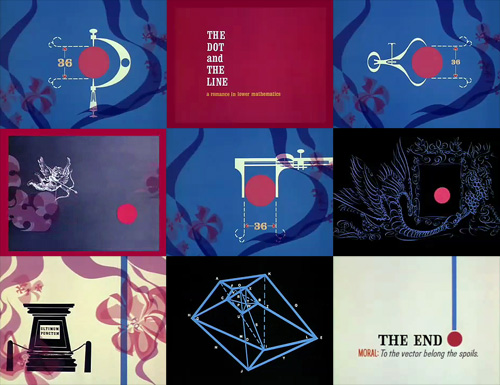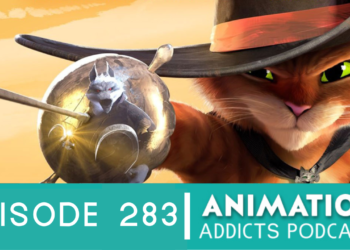When was the last time you cared about a straight line? Think hard. Go ahead, I’ll wait.
Have you come up with anything yet? If you haven’t, I don’t blame you. After all, a line is a line is a line. They’re everywhere, from papers to sidewalk cracks to… well, just about everything. They don’t really conjure up much emotion, either; after all, lines are just a basic part of the world we live in.
A master animator, however, can create a sympathetic character out of anything, no matter how simple. Chuck Jones was definitely a master animator and when he turned his attention to dots and lines, he turned these seemingly boring things into interesting, three-dimensional (no pun intended) characters. Jones did all this through his Oscar-winning 1965 short The Dot and the Line: A Romance in Lower Mathematics. That’s what we’ll be talking about today!
But, first, a little background. In 1963, Chuck Jones and his animation unit were fired from Warner Bros. Animation. This happened once before in the mid-1950s (during that time, Jones actually worked with Ward Kimball on Sleeping Beauty), but that was temporary. This time, however, the bigwigs at Warner Bros. were out for blood. Jones had incurred Warner Bros.’s wrath by scripting the feature-length film Gay Purr-ee for one of Warners’ biggest competitors, UPA. This was only a favor from Jones to an old friend (former Warners animator Abe Levitow), but this didn’t matter to the Warner bigwigs; they canned Jones and his unit.
Jones and his crew bounced back quickly and formed an independent animation studio named Sib-Tower 12 Productions. MGM turned to Sib-Tower and asked them for new Tom and Jerry shorts. Jones agreed, as long as MGM would release whatever additional shorts he wanted to do. MGM readily agreed, and Sib-Tower was absorbed into MGM Animation. Jones and his crew produced the Tom and Jerry shorts, as promised, but they also produced some wonderful stand-alone shorts. The first of these was The Dot and the Line.
The Dot and the Line was based on the book by Norton Juster (who also wrote the novel The Phantom Tollbooth, which Jones turned into a full-length film in 1970). Jones wanted to keep the short as true to the book as possible, so he asked Juster to adapt his own book. Juster did so and lifted most of the voice-over (the only dialogue in the film) directly from his book. Jones and his crew did a great job complementing the voice-over with striking, unique imagery, totally unlike anything ever seen in animation before. Jones also added his own special touch to the film by adding touches of that quirky humor that makes his Looney Tunes work so unique.
Here’s the plot in a nutshell: a straight vertical line is madly in love with a red dot, but she doesn’t pay attention to him (except to criticize him and his straightness). The dot reserves her affections for a wild squiggle, who engulfs her and sweeps her off on adventures. The line’s friends try to convince him to forget about the dot, but the line can’t; he daydreams about being an important line, and perhaps winning the dot’s love that way. One day, however, the line discovers that he can form angles if he concentrates hard enough. The line initially tries to make himself into a squiggle, but he decides to aspire higher and learns how to make complex shapes. With this new talent in his arsenal, he sets out to win the dot’s love.
The Dot and the Line is totally different from anything that Chuck Jones had ever done before (except maybe What’s Opera, Doc?). The movie is very modern art-like in its style; I guess that has a lot to do with the fact that the characters are all dots and lines. It also influences the backgrounds, though; they’re very abstract, made up of a lot of dabs of color and large shapes. The line’s daydreams kind of remind me of ’60s pop art; during those scenes, Jones and his crew took famous works of art and live-action still photos and stuck the line in the middle of them, which gave those pictures an extra detail that makes them complete. It’s obvious that Jones and his animators had fun making this film. They got the opportunity to do things they had never attempted before, and the joy they found in doing so really reflects in the film!
Chuck Jones won the third of his four Oscars for this film. Personally, I think a mere four Oscars for Jones is a travesty; there are many more of Jones’ Looney Tunes shorts that were definitely worthy of an Academy Award (like What’s Opera, Doc?, Duck Amuck, and One Froggy Evening, for instance). Jones did win a Lifetime Achievement Oscar toward the end of his life, though, so that’s okay! The Dot and the Line is definitely Oscar caliber as well, so it makes me happy that it won.
For whatever reason, The Dot and the Line seems to have disappeared from the collective memory. I guess I can understand why; after all, it doesn’t get shown on TV all that often. I can even understand that; after all, TV programmers probably figure that Jones’s Looney Tunes work is a little more kid friendly than The Dot and the Line. It’s also a little longer than Jones’s other shorts, so it doesn’t really fit easily into TV programming. There are a lot of logical reasons why The Dot and the Line has been semi-forgotten, but they don’t make me any less sad. This short definitely deserves more attention!
What do you think? Do you like ‘The Dot and the Line?’ What are your favorite Chuck Jones shorts?
Edited by: Hannah Wilkes







